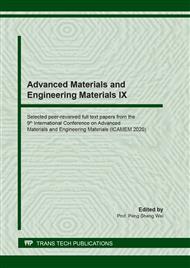[1]
Shui, Z. X., Qin, H., Wu, B., Ruan, Z. Y., Wang, L. S., & Tan, F. R., et al. (2015). Adaptive laboratory evolution of ethanologenic zymomonas mobilis strain tolerant to furfural and acetic acid inhibitors. Appl Microbiol Biotechnol 99: 5739-5748.
DOI: 10.1007/s00253-015-6616-z
Google Scholar
[2]
Kundu, C., & Lee, J. W. (2015). Optimization conditions for oxalic acid pretreatment of deacetylated yellow poplar for ethanol production. J Ind Eng Chem32: 298-304.
DOI: 10.1016/j.jiec.2015.09.001
Google Scholar
[3]
Ma, K. D., Zhiyong, R., Shui, Z. X., Wang, Y. W., Hu, G. Q., & He, M. X. (2016). Open fermentative production of fuel ethanol from food waste by an acid-tolerant mutant strain of zymomonas mobilis. Bioresource Technol.203: 295-302.
DOI: 10.1016/j.biortech.2015.12.054
Google Scholar
[4]
Chen, H., Chen, S., Li, C., & Shu, G.( 2015). Response surface optimization of lyoprotectant for lactobacillus bulgaricus during vacuum freeze-drying. Prep Biochem Biotech 45: 463.
DOI: 10.1080/10826068.2014.923451
Google Scholar
[5]
Nurhayati, Cheng, C. L., Nagarajan, D., & Chang, J. S. (2016). Immobilization of zymomonas mobilis, with Fe2O3-modified polyvinyl alcohol for continuous ethanol fermentation. Biochem Eng J 114: 298-306.
DOI: 10.1016/j.bej.2016.07.021
Google Scholar
[6]
Patil, S. S., & Jena, H. M.( 2015). Statistical optimization of phenol degradation by bacillus pumilus os1 using plackett–burman design and response surface methodology. Arab J Sci Eng 40: 2141-2151.
DOI: 10.1007/s13369-015-1765-z
Google Scholar
[7]
Shui, Z. X., Qin, H., Wu, B., Ruan, Z. Y., Wang, L. S., & Tan, F. R., et al. (2015). Adaptive laboratory evolution of ethanologenic zymomonas mobilis strain tolerant to furfural and acetic acid inhibitors. Appl Microbiol Biotechnol 99: 5739-5748.
DOI: 10.1007/s00253-015-6616-z
Google Scholar
[8]
Zhang, M., Eddy, C., Deanda, K., Finkelstein, M., & Picataggio, S. (1995). Metabolic engineering of a pentose metabolism pathway in ethanologenic zymomonas mobilis. Science 267: 240-243.
DOI: 10.1126/science.267.5195.240
Google Scholar
[9]
Chandel, A. K., Chan, E. S., Rudravaram, R., Narasu, M. L., Rao, L. V., & Ravindra, P. (2007). Economics and environmental impact of bioethanol production technologies: an appraisa l. Biotechnolo Mol Biol Rev2: 14-32.
Google Scholar
[10]
Cazetta, M. L., Celligoi, M. A. P. C., Buzato, J. B., & Scarmino, I. S.( 2007). Fermentation of molasses by zymomonas mobilis: effects of temperature and sugar concentration on ethanol productio -n. Bioresource Technol 98: 2824-2828.
DOI: 10.1016/j.biortech.2006.08.026
Google Scholar


